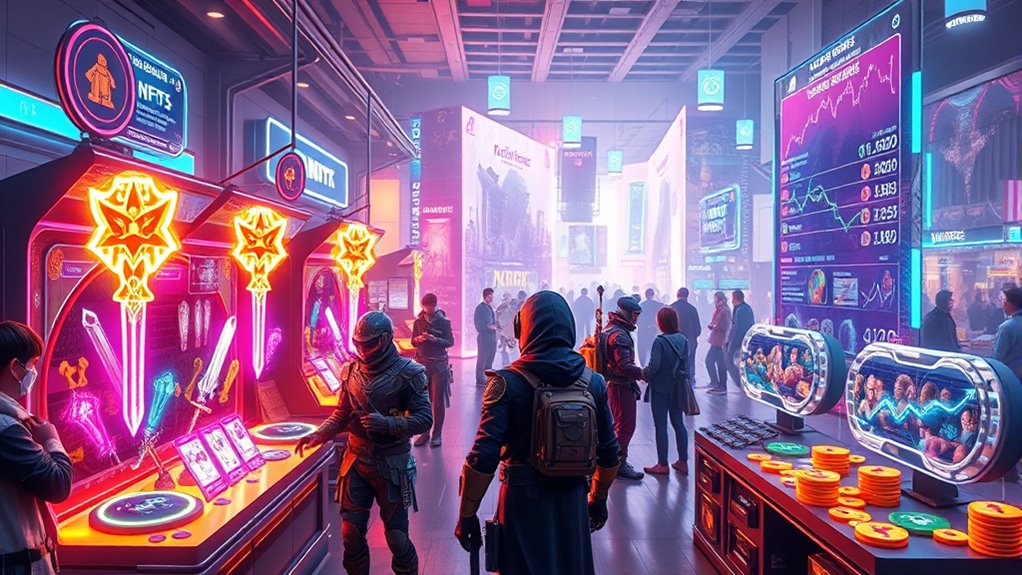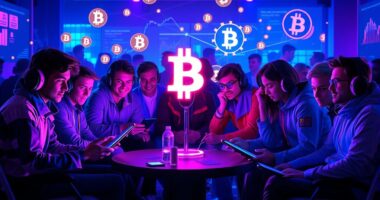To prevent hyperinflation in your in-game NFT economy, you should carefully manage virtual currency flow and player incentives. Limit how much currency players can earn, introduce sinks like upgrades or fees, and use economic models to keep supply and demand balanced. Finding the right balance between rewards and scarcity helps preserve NFT values and keeps the economy stable. Stick with us to discover more strategies for maintaining a healthy digital environment.
Key Takeaways
- Balance currency issuance with demand to prevent excess supply and maintain NFT value.
- Implement sinks like transaction fees or costly upgrades to reduce circulating virtual currency.
- Design reward systems that incentivize engagement without causing inflationary pressure.
- Use dynamic, data-driven economic models to adapt rewards and currency flow in real time.
- Monitor and adjust incentives regularly to sustain a stable, trustworthy virtual economy.

In-game NFT economies are transforming how players interact with digital assets, blurring the lines between gaming and blockchain technology. As you immerse yourself in these virtual worlds, you quickly realize that virtual currency isn’t just a means to buy in-game items anymore; it becomes part of a complex economy where each transaction impacts the broader digital ecosystem. Developers often implement mechanisms to motivate your engagement, such as rewarding you with NFTs that hold real-world value or offering incentives for trading and collecting. These player incentives drive participation, encouraging you to invest time and effort into acquiring rare assets, which in turn fuels the economy’s growth. However, this dynamic also introduces risks—particularly hyperinflation—that can destabilize the entire virtual world you’re part of.
Hyperinflation happens when the supply of virtual currency floods the economy without a corresponding increase in demand or asset value. When this occurs, prices for NFTs and other digital assets plummet, eroding their worth and discouraging further investment. As a player, you might notice that your once-valuable digital collectibles become worthless overnight, leading to frustration and a loss of trust in the economy. Developers aiming to prevent this scenario often need to carefully balance the issuance of virtual currency against the activity levels within the game. They might limit how much currency can be earned or introduce sinks—ways to remove currency from circulation—such as costly upgrades or transaction fees, to keep the economy stable. Implementing vetted economic models can help maintain balance and prevent inflationary spirals.
You should also be aware that managing player incentives is key to avoiding hyperinflation. If rewards are too generous or too easy to obtain, the virtual currency supply can balloon rapidly. Conversely, if incentives are too scarce, player engagement drops, reducing activity and liquidity in the economy. Striking the right balance involves creating a system that encourages ongoing participation without flooding the market with excess virtual currency. This approach guarantees that NFTs retain their value and that the economy remains sustainable over time. In practice, developers often introduce dynamic reward systems, adjusting incentives based on current economic conditions, and implementing controls on currency issuance.
Ultimately, understanding how virtual currency and player incentives interact is essential for maintaining a healthy in-game NFT economy. By carefully managing these elements, you can enjoy a vibrant, stable digital environment where assets hold their worth and your efforts are rewarded fairly. This balance fosters a trustworthy ecosystem that benefits both players and developers, making the virtual world more engaging and resilient against threats like hyperinflation.
Frequently Asked Questions
How Do In-Game NFT Economies Impact Real-World Economies?
You should know that in-game NFT economies impact real-world economies by transforming virtual currency into tangible value, influencing market speculation. When players trade NFTs, it can lead to increased financial activity and investment outside the game. This dynamic can boost local economies or create volatility, depending on how stable or speculative the market becomes. So, your virtual transactions may have real-world effects, especially when large sums or speculative behaviors are involved.
What Are the Best Practices to Prevent NFT Market Manipulation?
To prevent NFT market manipulation, you should promote market transparency by providing clear transaction data and fair pricing mechanisms. Encourage player governance, allowing players to participate in decision-making processes that regulate the marketplace. Regular audits and implementing anti-fraud measures also help. By fostering transparency and player involvement, you create a more stable environment, reducing the risk of manipulation and ensuring a healthier NFT economy in virtual worlds.
How Can Developers Ensure Long-Term Sustainability of Nft-Based Economies?
You can guarantee long-term sustainability of NFT-based economies by designing creative tokenomics that balance supply and demand, preventing inflation. Incorporate player governance, giving users a say in economic decisions, which fosters engagement and stability. Regularly adjust token issuance and introduce utility-driven NFTs to maintain value. By aligning incentives and involving players in governance, you create a resilient economy that adapts over time and avoids collapse.
What Role Do Players Have in Stabilizing In-Game NFT Inflation?
You play a vital role in stabilizing in-game NFT inflation by understanding player incentives and practicing economic literacy. When you make informed decisions about buying, selling, or trading NFTs, you help maintain a balanced economy. By staying aware of how your actions impact supply and demand, you contribute to a sustainable virtual world. Your responsible participation ensures the longevity and stability of the in-game economy for everyone.
Are There Legal Regulations Affecting In-Game NFT Economies Globally?
You should know that legal regulations impact in-game NFT economies differently across countries, influenced by international jurisdiction. Developers and players must verify legal compliance with local laws on digital assets, securities, and taxation. These regulations can vary widely, so staying informed about international rules helps prevent legal issues. Ultimately, understanding these legal frameworks allows you to participate responsibly and supports a sustainable virtual economy.
Conclusion
To keep in-game NFT economies healthy, you should focus on balancing supply and demand carefully. Avoid flooding the market with too many NFTs, which can cause hyperinflation and devalue assets. Implementing scarcity measures and responsive economic policies helps maintain stability. By staying vigilant and adjusting your approach as the virtual world evolves, you can create a sustainable economy that benefits players and preserves the value of NFTs over time.









